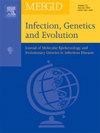首次报道在孟加拉国选定地区的鸡中出现新型新城疫病毒XIII.2.3亚基因型。
IF 2.6
4区 医学
Q3 INFECTIOUS DISEASES
引用次数: 0
摘要
新城疫病(ND)是影响孟加拉国家禽业的最具经济破坏性的传染病之一。本研究旨在描述2023年10月至2024年12月期间孟加拉国加齐浦尔、坦盖尔和迈门辛格地区鸡中流行的新城疫病毒(NDV)的病原型、基因型、进化差异和突变。收集疑似nd样本,包括肺、气管和盲肠扁桃体组织,进行处理,并通过尿囊腔接种到10-12日龄的胚胎鸡蛋(ECEs)中。孵育24 h后收集尿囊液,使用特异性引物针对融合(F)基因,通过RT-PCR鉴定毒性NDV。采用平均死亡时间(MDT)、脑内致病性指数(ICPI)和静脉致病性指数(IVPI)评估致病性。通过F基因全测序和系统发育分析证实了F基因的致病型和基因型。进一步的进化分化和突变分析使用MEGA-11软件。RT-PCR获得了254 bp的特异性扩增产物,表明NDV具有毒性。致病性指数mdt(1.5)和IVPI(>1.70)证实是一种速度性菌株。完整的F基因测序显示了“RRQKRF”的F蛋白切割位点基序,而系统发育分析将分离物归类为基因型XIII下的XIII.2.3亚基因型。进化差异(0.00-0.06)和中和表位1和2(分别位于第74和170个氨基酸)的突变表明遗传多样性中等。本研究是孟加拉国第一份确定在选定地区出现与鸡死亡率相关的新型XIII.2.3基因型新城疫的报告。本文章由计算机程序翻译,如有差异,请以英文原文为准。
First report of the emergence of novel sub-genotype XIII.2.3 of Newcastle disease virus in chickens from selected regions of Bangladesh
Newcastle disease (ND) is one of the most economically devastating infectious diseases impacting the poultry industry in Bangladesh. This study aimed to characterize the pathotype, genotype, evolutionary divergence, and mutations of circulating virulent Newcastle disease virus (NDV) in chickens from the Gazipur, Tangail, and Mymensingh districts of Bangladesh between October 2023 and December 2024. ND-suspected samples, including lung, trachea, and caecal tonsil tissues, were collected, processed, and inoculated into 10–12-day-old embryonated chicken eggs (ECEs) via the allantoic cavity. Allantoic fluids were harvested after 24 h of incubation, and virulent NDV was identified through RT-PCR targeting the fusion (F) gene using specific primers. Pathogenicity was assessed using the mean death time (MDT), intracerebral pathogenicity index (ICPI), and intravenous pathogenicity index (IVPI). The pathotype and genotype were confirmed by complete sequencing of the F gene and phylogenetic analysis. Further evolutionary divergence and mutations were analyzed using MEGA-11 software. RT-PCR yielded specific amplification of a 254-bp product indicative of virulent NDV. Pathogenicity indices—MDT (<60 h), ICPI (>1.5), and IVPI (>1.70)—confirmed a velogenic strain. Complete F gene sequencing revealed an F-protein cleavage site motif of “RRQKRF,” while phylogenetic analysis classified the isolates as belonging to sub-genotype XIII.2.3 under genotype XIII. Evolutionary divergence (0.00–0.06) and mutations at neutralizing epitopes 1 and 2 (at the 74th and 170th amino acids, respectively) suggested moderate genetic diversity. This study represents the first report in Bangladesh identifying the emergence of the novel sub-genotype XIII.2.3 of genotype XIII NDV associated with chicken mortality in selected regions.
求助全文
通过发布文献求助,成功后即可免费获取论文全文。
去求助
来源期刊

Infection Genetics and Evolution
医学-传染病学
CiteScore
8.40
自引率
0.00%
发文量
215
审稿时长
82 days
期刊介绍:
(aka Journal of Molecular Epidemiology and Evolutionary Genetics of Infectious Diseases -- MEEGID)
Infectious diseases constitute one of the main challenges to medical science in the coming century. The impressive development of molecular megatechnologies and of bioinformatics have greatly increased our knowledge of the evolution, transmission and pathogenicity of infectious diseases. Research has shown that host susceptibility to many infectious diseases has a genetic basis. Furthermore, much is now known on the molecular epidemiology, evolution and virulence of pathogenic agents, as well as their resistance to drugs, vaccines, and antibiotics. Equally, research on the genetics of disease vectors has greatly improved our understanding of their systematics, has increased our capacity to identify target populations for control or intervention, and has provided detailed information on the mechanisms of insecticide resistance.
However, the genetics and evolutionary biology of hosts, pathogens and vectors have tended to develop as three separate fields of research. This artificial compartmentalisation is of concern due to our growing appreciation of the strong co-evolutionary interactions among hosts, pathogens and vectors.
Infection, Genetics and Evolution and its companion congress [MEEGID](http://www.meegidconference.com/) (for Molecular Epidemiology and Evolutionary Genetics of Infectious Diseases) are the main forum acting for the cross-fertilization between evolutionary science and biomedical research on infectious diseases.
Infection, Genetics and Evolution is the only journal that welcomes articles dealing with the genetics and evolutionary biology of hosts, pathogens and vectors, and coevolution processes among them in relation to infection and disease manifestation. All infectious models enter the scope of the journal, including pathogens of humans, animals and plants, either parasites, fungi, bacteria, viruses or prions. The journal welcomes articles dealing with genetics, population genetics, genomics, postgenomics, gene expression, evolutionary biology, population dynamics, mathematical modeling and bioinformatics. We also provide many author benefits, such as free PDFs, a liberal copyright policy, special discounts on Elsevier publications and much more. Please click here for more information on our author services .
 求助内容:
求助内容: 应助结果提醒方式:
应助结果提醒方式:


